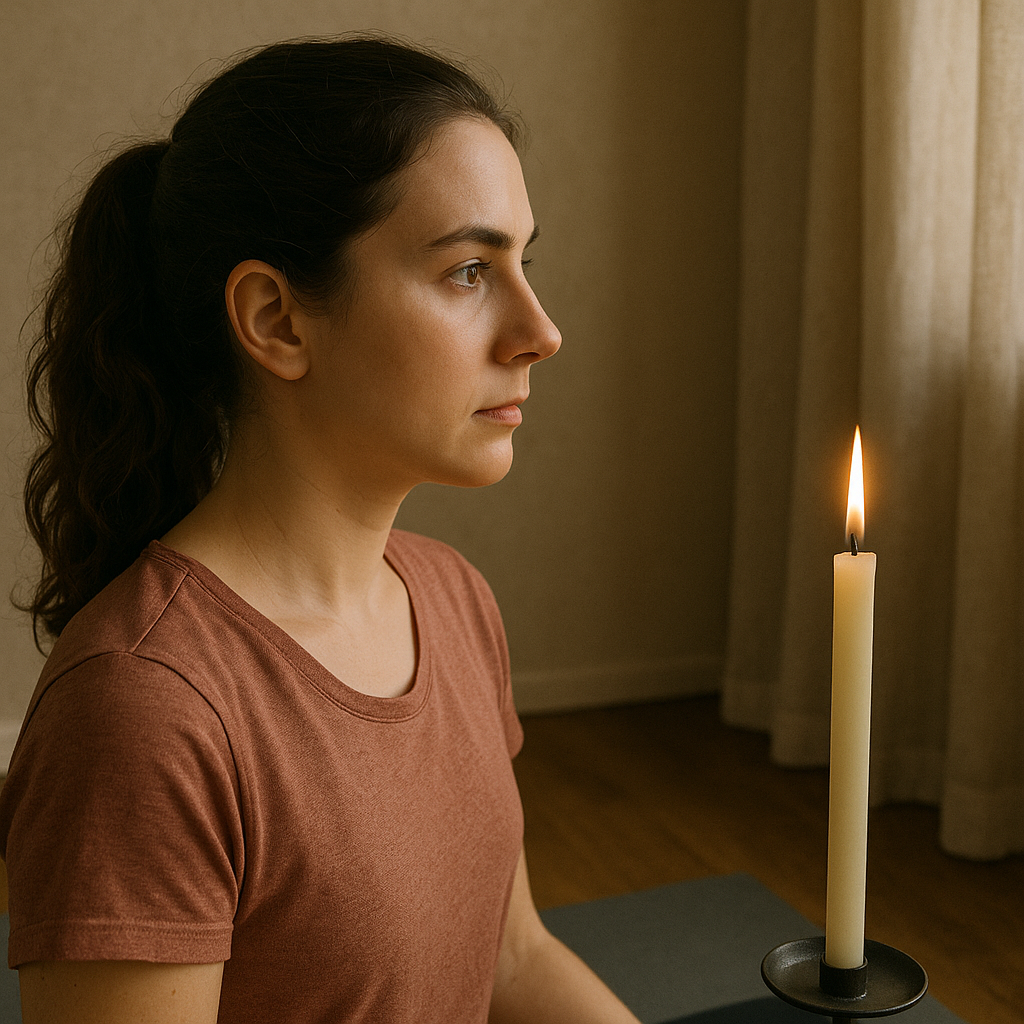Ask Ayurvedic doctor a question and get a consultation online on the problem of your concern in a free or paid mode. More than 2,000 experienced doctors work and wait for your questions on our site and help users to solve their health problems every day.
Shop Now in Our Store
What Is Tratak Kriya? Meaning, Practice Steps, and Yogic Benefits

Tratak Kriya is one of those ancient yogic techniques that seems simple on the surface—but dig a little deeper, and you’ll find it’s incredibly powerful. So, what is Tratak Kriya exactly? And why are so many modern yogis, wellness coaches, and even eye doctors talking about it?
In this article, we'll explore the real Tratak Kriya meaning, how to do it properly, and why it’s gaining popularity. We’ll break down the Tratak Kriya steps, dive into its origins, benefits (yes, there are many), and even talk about Tratak Kriya side effects and when it’s best to practice Tratak Kriya. Whether you're new to yoga or have been at it for years, this kriya might just become your favorite new tool for focus and inner clarity.
Let’s get into it.
What Is Tratak Kriya and Its Meaning in Yogic Practice
The term Tratak Kriya comes from Sanskrit, where "Tratak" means to gaze or look steadily, and "Kriya" refers to a cleansing action. So, in simple terms, Tratak Kriya meaning is focused gazing that cleanses the mind and body. But it’s not just about staring at something for a while—there’s intention, awareness, and discipline behind it.
What Is Tratak Kriya Related To? Focus and Cleansing
So what is Tratak Kriya related to? Primarily, it's connected to the third eye chakra, which governs intuition and mental clarity. It’s also deeply rooted in the broader practice of shatkarmas (the six yogic cleansing techniques). That means it's not only for mental wellness, but also a purification process, removing what yogis call "mental noise" and internal clutter.
Tratak is often practiced to develop dharana, or single-pointed focus. If you've ever found yourself struggling to concentrate—especially in today's overstimulating world—this is where tratak truly shines. It's kind of like a meditation practice, but with your eyes wide open (literally!).
Tratak Kriya in Yoga Tradition
Tratak Kriya in yoga isn’t new. It has been around for centuries, mentioned in ancient Hatha Yoga texts like the Hatha Yoga Pradipika. Traditionally, it was practiced not only to calm the mind but also to prepare the yogi for deeper meditation. In fact, many spiritual seekers use Tratak Kriya yoga before their main meditation session as a way to settle their attention.
Some monks even practiced tratak for hours at a time, gazing at a candle flame until they could visualize it clearly even with their eyes closed. Sounds intense, right? But don’t worry—we're gonna keep things a bit more beginner-friendly here.

Tratak Kriya Benefits for Eyes, Mind, and Inner Clarity
Now let’s talk about why people are flocking to learn this practice. The benefits of Tratak Kriya are both physical and mental.
First and foremost, Tratak Kriya for eyes is a major plus. By gazing steadily at a single point (often a candle flame), your eye muscles get a gentle workout. It may help reduce eye strain, improve focus, and even boost visual memory. Sounds weird? Maybe. But try it consistently, and you’ll start to notice your eyes feel less fatigued—especially if you work on a computer all day like most of us do!
Mentally, it helps cut through distraction. Think of it as a brain detox. It trains your mind to stay put, even when it wants to wander. And that, friends, is rare these days.
Some of the core Tratak Kriya benefits include:
-
Enhanced concentration and memory
-
Calmer nervous system
-
Sharper vision and reduced digital eye strain
-
Greater emotional balance
-
Improved sleep (for some people, at least!)
But hey—not everything works the same for everyone. That’s life.

How to Do Tratak Kriya: Step-by-Step Procedure
Okay, so how to do Tratak Kriya? It's easier than you think—but it takes practice.
Find a quiet space. Light a candle and place it about an arm’s length away at eye level. Sit comfortably, with your spine straight. Now, gaze softly at the flame. Don’t strain. Just observe.
That’s it. Start with 2–3 minutes and build from there. When tears form (and they will), that’s part of the process—it’s cleansing.
Types of Tratak Kriya
There’s no one-size-fits-all when it comes to Tratak Kriya. Different types suit different goals—and people. Here are the most commonly practiced forms:
1. Candle Flame Tratak (Jyoti Tratak)
This is the most popular type. You stare at a candle flame placed at eye level. It's especially helpful for Tratak Kriya for eyes and mental clarity.
2. Bindi or Dot Tratak
Draw a black dot on white paper, hang it on the wall, and gaze at it. Simple, right? This one’s great for beginners or for days when you want something less... flickery than a candle.
3. Mirror Tratak
Yes, it’s just what it sounds like—you gaze into your own eyes in a mirror. Sounds intense? It kinda is. This practice can bring deep emotional awareness (sometimes even tears). Use it with caution.
4. Nature Tratak
Gazing at a natural object, like the moon, a star, or even a flower. This is more relaxing, meditative, and used often in retreats or outdoor settings.
5. Abstract or Visualization Tratak
Instead of a physical object, you visualize a shape or light in your mind’s eye. This one is advanced—and not something most people can jump into day one.
Each type has its own vibe, and depending on your mood or intention, you might switch it up.
Tratak Kriya for Eyes and Concentration
Let’s take a deeper look at how this kriya works specifically for vision and focus. Digital screens are everywhere, and most of us blink less than we should. That causes our eyes to dry out and muscles to weaken (fun times, right?). This is where Tratak Kriya for eyes comes in clutch.
The steady gaze improves ocular endurance, helps balance eye movement, and may reduce fatigue. Plus, when you tear up during the practice (which is totally normal), it actually helps flush out toxins from the eye region.
But even beyond the eyes, the mental benefits are big. Tratak builds dharana—concentration. When you teach your mind to focus on a flame for 5 minutes, it slowly starts to focus better on tasks, goals, relationships. Honestly, it’s like a mental sharpening tool you didn’t know you needed.
Try it for 7 days straight, and you might find yourself reaching for your phone a little less... or noticing you remember things a bit more clearly. Like where you left your keys.
Best Time to Practice Tratak and Preparation Tips
Wondering when to do Tratak Kriya? Timing matters more than you’d think.
The best time is either early morning before sunrise or evening just after sunset. Your body is naturally more relaxed, and the dim lighting helps you focus on the flame or object without distractions. But hey, if all you have is your lunch break—go for it. The key is consistency, not perfection.
Some quick preparation tips:
-
Choose a quiet, dimly lit room.
-
Sit in a comfortable meditative posture (cross-legged or on a chair).
-
Make sure the candle or object is at eye level.
-
Remove glasses or contact lenses during practice.
-
Don’t force yourself to not blink—allow it naturally, especially in the beginning.
Also, don’t expect magic on day one. Like anything in yoga, this takes time. Think of it like flossing... for your mind and eyes.
Tratak Kriya Side Effects and Safety Precautions
Let’s be real—while Tratak Kriya has loads of benefits, it’s not all sunshine and candlelight. There can be downsides, especially if you go too hard, too fast. Practicing without proper guidance or overdoing it may lead to:
-
Eye strain or headaches (if you're forcing the gaze too long)
-
Dizziness or nausea (usually from holding your breath or stiff posture)
-
Emotional release (which can feel overwhelming if unexpected)
These aren’t dealbreakers, but they are worth keeping in mind. Always listen to your body. If you start feeling off, take a break, blink a few times, maybe even come back to it another day.
Tratak Kriya Precautions to Remember:
-
Start small. Just 2–3 minutes in the beginning is enough.
-
Never force your eyes. Blinking is okay—seriously, don’t try to be a hero.
-
Avoid if you have serious eye conditions like glaucoma or severe dry eye unless a doctor says it’s okay.
-
Don’t practice when you're overly tired or emotional. Tratak can amplify emotions and mess with your sleep if done too close to bedtime.
-
Pregnant people, epileptics, or those with mental health conditions should consult with a professional first.
If you’re unsure, check in with a yoga teacher. That’s what they’re there for.
Conclusion
So, to wrap it all up: What is Tratak Kriya? It’s a deceptively simple but profoundly impactful yogic technique that can train your focus, clean your mind, and even sharpen your eyesight. Whether you’re curious about Tratak Kriya in yoga, hoping to improve your vision, or searching for some inner calm in a world that rarely stops buzzing—this kriya offers something for almost everyone.
From boosting concentration to releasing emotional blocks, the benefits of Tratak Kriya are hard to ignore. But like any practice, it should be approached with patience, consistency, and respect.
Feeling inspired? Light a candle, dim the lights, and give it a try tonight.
FAQs
What is Tratak Kriya used for?
Tratak Kriya is mainly used to improve concentration, enhance mental clarity, and support eye health. It’s also a form of meditation that helps reduce stress, sharpen memory, and activate the third eye chakra.
Who should avoid Trataka?
People with epilepsy, severe eye disorders, or mental health issues like anxiety or psychosis should avoid Tratak or consult a health professional first. Pregnant individuals should also be cautious.
What happens after a Tratak?
It varies! Some people feel super calm, others get emotional. You might notice clearer thoughts, better sleep, or more vivid dreams. Eye strain can happen if you overdo it, but generally you’ll feel refreshed and focused after a session.
Call to Action:
If you found this article helpful or know someone struggling with screen fatigue or focus issues, share it! You might just light the way (literally and figuratively) for someone else. And if you’ve already tried Tratak Kriya, drop a comment or DM with your experience—we’d love to hear about your journey.
Namaste, and happy gazing 🔥
This article is checked by the current qualified Dr Sujal Patil and can be considered a reliable source of information for users of the site.

